LeMoyne–Owen College is a private historically black college affiliated with the United Church of Christ and located in Memphis, Tennessee. It resulted from the 1968 merger of historically black colleges and other schools established by northern Protestant missions during and after the American Civil War.
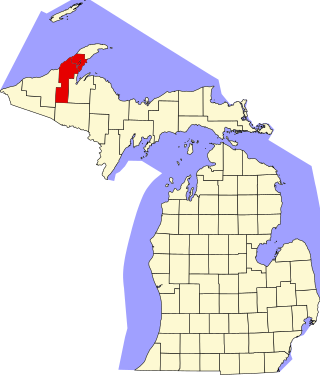
This is a list of the National Register of Historic Places listings in Houghton County, Michigan.

Midtown is a neighborhood in St. Louis, Missouri. It is located 3 miles (4.8 km) west of the city riverfront at the intersection of Grand and Lindell Boulevards. It is home to the campus of Saint Louis University and the Grand Center Arts District.

Downtown Columbia is the central business, government, and social core of Columbia, Missouri and the Columbia Metropolitan Area. Three colleges — the University of Missouri, Stephens College, and Columbia College — all border the area. Downtown Columbia is an area of approximately one square mile surrounded by the University of Missouri on the south, Stephens College to the east, and Columbia College on the north. The area serves as Columbia's financial and business district and is the topic of a large initiative to draw tourism, which includes plans to capitalize on the area's historic architecture and Bohemian characteristics. The downtown skyline is relatively low and is dominated by the 10-story Tiger Hotel, built in 1928, and the 15-story Paquin Tower.
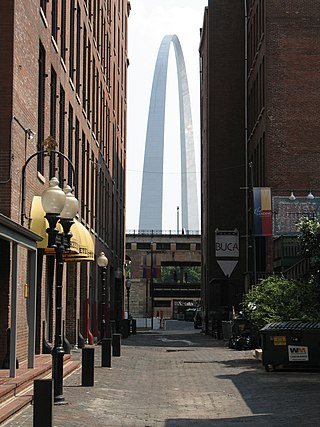
The architecture of St. Louis exhibits a variety of commercial, residential, and monumental architecture. St. Louis, Missouri is known for the Gateway Arch, the tallest monument constructed in the United States. Architectural influences reflected in the area include French Colonial, German, early American, European influenced, French Second Empire, Victorian, and modern architectural styles.

Clarksville Historic District is a national historic district located at Clarksville, Pike County, Missouri. The district encompasses 65 contributing buildings in the central business district and surrounding residential sections of Clarksville. It developed between about 1840 and 1930, and includes representative examples of Greek Revival, Italianate, and Queen Anne style architecture. Located in the district is the separately listed Clifford-Wyrick House. Other notable buildings include the City Hall (1910), Sentinel Building (1867-1871), Clifford Banking Company, La Crosse Lumber Company (1923), Presbyterian Church, Methodist Church (1906), Masonic Temple (1903), and Clarksville Public Library (1910).

The St. Charles Historic District is a national historic district located at St. Charles, St. Charles County, Missouri. It is the site of the first permanent European settlement on the Missouri River and of the embarkation of Lewis and Clark's journey of exploration along the Missouri. The first state capital of Missouri and over one hundred other historic buildings are located in the district.

The Old City Hall, also known as Oxford Flats, is located just north of downtown along a commercial corridor in Davenport, Iowa, United States. It was individually listed on the National Register of Historic Places in 1983. In 2020 it was included as a contributing property in the Davenport Downtown Commercial Historic District.

The National Register of Historic Places listings in downtown Kansas City, Missouri is intended to be a complete list of the properties and districts on the National Register of Historic Places in downtown Kansas City, Missouri, United States. Downtown Kansas City is defined as being roughly bounded by the Missouri River to the north, 31st Street to the south, Troost Avenue to the east, and State Line Road to the west. The locations of National Register properties and districts are in an online map.
Morris Frederick Bell was an American architect known primarily for his institutional buildings but also for his domestic and commercial structures. His best known work is the David R. Francis Quadrangle the historic center of the University of Missouri including Jesse Hall. He also designed state correctional schools in Boonville, Chillicothe, and Tipton; and state mental hospitals in Fulton, Higginsville, and Nevada. Bell, a democrat, was also active in civic life, especially Masonic organizations. He trained and employed William Lincoln Garver as an assistant. Garver would later go on to have a stand-alone career.

The Mena Commercial Historic District encompasses the historic downtown area of Mena, Arkansas, the county seat of Polk County in western Arkansas. The district extends along Mena Street between Port Arthur and Gillham Avenues, extending a short way to the south on Sherwood Avenue, opposite the railroad tracks for which the town's existence is responsible. Mena was founded as a major railroad service town for the Kansas City, Pittsburg and Gulf Railroad, as its site was located midway between Port Arthur, Texas and Kansas City, Missouri. The railroad located a major service yard here, and the town grew up around it. Most of its commercial center was developed between 1896 and 1940, with a variety of one and two-story commercial brick buildings in typical early 20th-century styles. The district, listed on the National Register of Historic Places in 2009, includes four properties previously listed separately: the railroad station, Mena City Hall, the former Elks Lodge, and the former Studebaker Showroom.

Lucas County Courthouse Square Historic District is a nationally recognized historic district located in Chariton, Iowa, United States. It was listed on the National Register of Historic Places in 2014. At the time of its nomination the district consisted of 76 resources, including 56 contributing buildings, one contributing site, one contributing structure, three contributing objects, 14 noncontributing buildings, one noncontributing structure, and one noncontributing object. The historic district covers the city's central business district in the original town plat. The buildings were either built or remodeled between 1867 and 1963, and range from one to three stories in height. They all have brick exteriors. Of the older buildings, the commercial Italianate style is dominant.
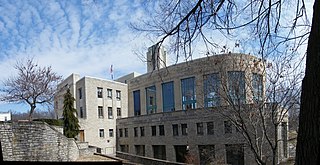
Excelsior Springs Hall of Waters Commercial East Historic District is a national historic district located at Excelsior Springs, Clay County, Missouri. It encompasses 24 contributing buildings and 2 contributing structures in the central business district of Excelsior Springs. The district developed between about 1894 and 1948, and includes representative examples of Victorian architecture. The central feature of the district, the separately listed Hall of Waters, is a five level, Art Deco / Depression Modern style reinforced concrete building. Other notable buildings include the Flanders Dry Goods Store, A.M. Howard Drug Store (1905-1909), Clay County State Bank (1906), The Huey Building (1908), Oriental Bazaar Gift Store (1908), The Excelsior Baths and Broadway Rooms, Fraternal Order of Eagles Lodge Hall, The Kennedy Building (1902), First National Bank Building, The Francis Hotel, and The Auditorium.
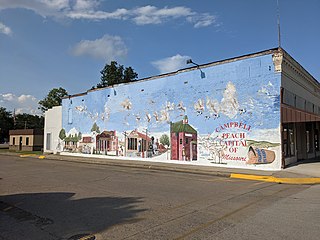
Campbell Commercial Historic District is a national historic district located at Campbell, Dunklin County, Missouri. The district encompasses 19 contributing buildings in the central business district of Campbell. The district developed between about 1883 and 1930, and includes representative examples of Colonial Revival style architecture. Notable buildings include the Rice Hardware Company, Cotton Belt Hotel, City Hall (1906), Boyd's Department Store, and Pol-Mac Hotel.

Fayette Courthouse Square Historic District is a national historic district located at Fayette, Howard County, Missouri. The district encompasses 35 contributing buildings in the central business district of Fayette. It developed between about 1828 and 1947 and includes representative examples of Second Empire, Italianate, and Romanesque Revival style architecture. Located in the district is the separately listed Dr. Uriel S. Wright Office. Other notable buildings include the Fayette Public Library (1914), City Hall (1925), New Opera House Block (1903), A. F. Davis Bank, Commercial Bank (1910), The New Century Block Building (1902), Bell Block Building (1883), U.S. Post Office Building (1925), Howard County Jail and Residence, and Howard County Courthouse (1887).
Sarcoxie Public Square Historic District is a national historic district located at Sarcoxie, Jasper County, Missouri. The district encompasses 26 contributing buildings, 1 contributing site, and 1 contributing structure in the central business district of Sarcoxie. It developed between about 1890 and 1965 and includes representative examples of commercial style architecture. Notable contributing resources include the Public Square and Gazebo ; Sarcoxie Record (1889), Sarcoxie City Hall, Sarcoxie Police, Parmley Garage (1910-1911), Sarcoxie Public Library, and Gene Taylor Library & Museum.
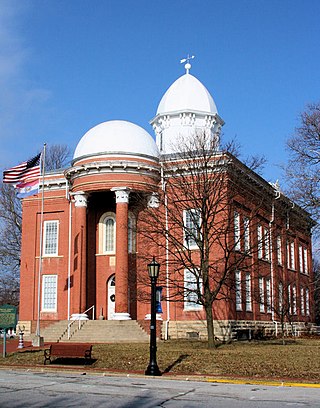
Moniteau County Courthouse Square is a national historic district located at California, Moniteau County, Missouri. The district encompasses 21 contributing buildings and 1 contributing site in the central business district of California. It developed between about 1867 and 1900, and includes representative examples of Classic Revival architecture. Contributing buildings include the Moniteau County Courthouse (1867-1868) and a variety of commercial buildings contemporary with the courthouse, dating from the mid to late-19th century.

Neosho Commercial Historic District is a national historic district located at Neosho, Newton County, Missouri. The district encompasses 38 contributing buildings in the central business district of Neosho. It developed between about 1868 and 1943, and includes representative examples of Victorian and Modern Movement architecture. Notable buildings include the Newton County Courthouse (1936), Newton County Jail (1888), Haas Building (1906), First National Bank (1922), Auditorium and City Hall (1938), Masonic Lodge, and Newton County Bank (1884).
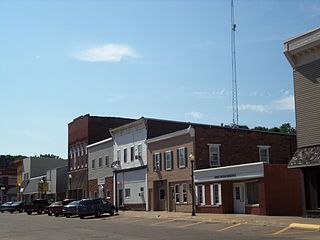
The Wilton Commercial Historic District is a nationally recognized historic district located in Wilton, Iowa, United States. It was listed on the National Register of Historic Places in 2016. At the time of its nomination it consisted of 47 resources, which included 32 contributing buildings, one contributing structure and 14 non-contributing buildings. Wilton got its start when the Mississippi and Missouri Railroad, later the Chicago, Rock Island and Pacific, was surveyed through this area in 1853. It was named for Wilton, Maine, the hometown of one of the founders.




















